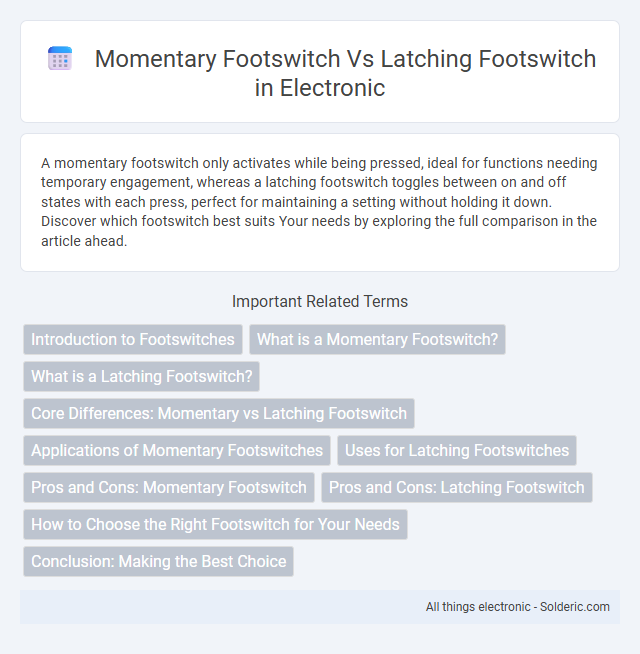A momentary footswitch only activates while being pressed, ideal for functions needing temporary engagement, whereas a latching footswitch toggles between on and off states with each press, perfect for maintaining a setting without holding it down. Discover which footswitch best suits Your needs by exploring the full comparison in the article ahead.
Comparison Table
| Feature | Momentary Footswitch | Latching Footswitch |
|---|---|---|
| Operation | Active only while pressed | Toggles state with each press |
| Use Case | Temporary effects, quick triggers | Toggle effects, switch modes |
| State | Returns to default instantly | Maintains on/off state |
| Common Devices | Guitar pedals, keyboards | Amplifiers, multi-effects units |
| Wiring | Normally open (NO) switch | Maintains connection until toggled |
| User Feedback | Momentary action feedback | Visual indicator common |
Introduction to Footswitches
Momentary footswitches activate a function only while pressed, ideal for tasks requiring temporary control such as sustain effects on guitars. Latching footswitches maintain their state after being pressed, perfect for toggling settings on or off without holding the switch down. Understanding the difference helps you choose the right footswitch for your musical or device control needs.
What is a Momentary Footswitch?
A momentary footswitch is a type of switch that only stays active while being pressed, instantly returning to its default off position when released. This switch is widely used in musical instruments, effects pedals, and lighting controls where temporary activation is required. Your equipment benefits from precise control and quick toggling without the switch remaining engaged after your foot lifts off.
What is a Latching Footswitch?
A latching footswitch maintains its on or off state after being pressed, allowing continuous control without the need to hold the switch down. It is commonly used in guitar pedals and amplifiers to toggle effects or power on and off. Your setup benefits from a latching footswitch when you require hands-free, sustained activation without constant pressure.
Core Differences: Momentary vs Latching Footswitch
Momentary footswitches activate a circuit only while being pressed, making them ideal for functions like sustain pedals or temporary effects activation. Latching footswitches maintain their on or off state after being pressed, commonly used for toggling effects or switching channels with a single tap. The core difference lies in momentary switches requiring continuous pressure for operation, whereas latching switches toggle states with a single press and release.
Applications of Momentary Footswitches
Momentary footswitches are widely used in applications requiring temporary activation, such as guitar effects pedals, where the signal is engaged only while the switch is pressed. They are essential in audio and broadcast equipment for push-to-talk functions, enabling clear communication by allowing microphone activation solely during depression of the switch. Industrial machinery and medical devices also utilize momentary footswitches for precision control, ensuring operations occur only as long as the operator maintains pressure.
Uses for Latching Footswitches
Latching footswitches are commonly used in guitar pedals, amplifiers, and other electronic devices where the user needs to toggle a function on or off without holding the switch down. These footswitches maintain their state after being pressed, making them ideal for effects like distortion, reverb, and channel switching. Your setup benefits from latching footswitches when seamless control and hands-free operation over settings are essential.
Pros and Cons: Momentary Footswitch
Momentary footswitches offer precise control for effects that require temporary activation, making them ideal for applications like delay or reverb where you want to engage the effect only while holding the switch. Their main drawback is the inability to toggle states, which can limit usability in scenarios needing a continuous on/off function. You benefit from quicker response times and reduced risk of accidental toggling, but must manage activation manually, which may not suit all playing styles.
Pros and Cons: Latching Footswitch
Latching footswitches offer the advantage of maintaining their on or off state without continuous pressure, making them ideal for applications like guitar effects pedals where you want to toggle settings easily. Pros include hands-free operation and stability during use, but drawbacks involve potential accidental activation and the need to press again to switch states, which can disrupt performance flow. Your choice depends on whether you prioritize consistent toggling or momentary control for precise, temporary activation.
How to Choose the Right Footswitch for Your Needs
Choosing the right footswitch depends on your specific application and control preferences, as momentary footswitches provide temporary activation ideal for effects like wah-wah pedals or boost functions, whereas latching footswitches toggle on/off states suitable for channel switching or sustain pedals. Consider the type of equipment you're using, the desired user interaction, and whether you need momentary control or a stable on/off state. Evaluating compatibility with your gear's input requirements and the nature of your performance style ensures optimal functionality and responsiveness.
Conclusion: Making the Best Choice
Choosing between a momentary footswitch and a latching footswitch depends on the specific application and user preference, with momentary switches ideal for temporary actions such as sustain or effects bypass, while latching switches excel in toggling states like on/off or channel switching. Consider the required control style, device compatibility, and whether instantaneous or sustained activation is needed to determine the optimal fit. Professional musicians and technicians often select momentary switches for dynamic performance control, whereas latching switches provide reliable and straightforward operation for consistent state changes.
momentary footswitch vs latching footswitch Infographic

 solderic.com
solderic.com